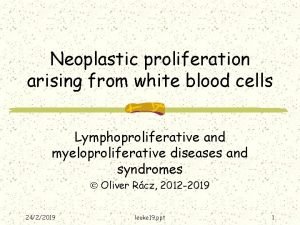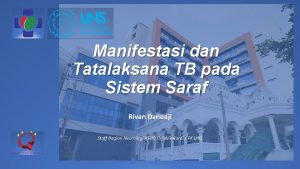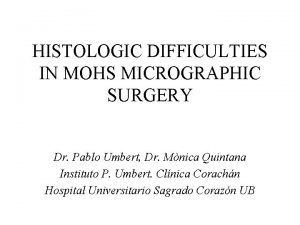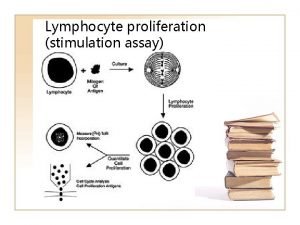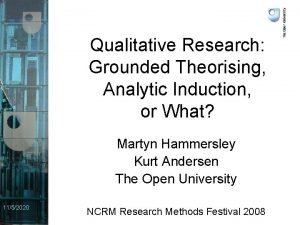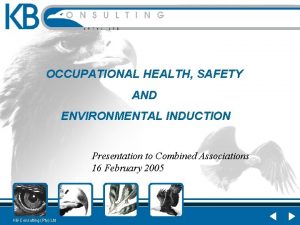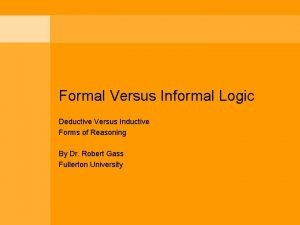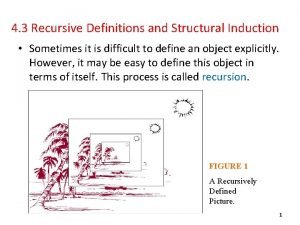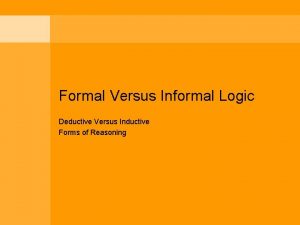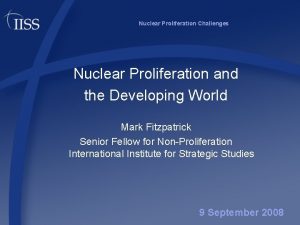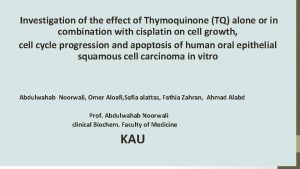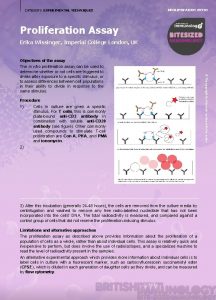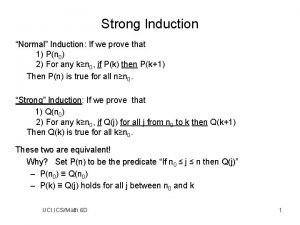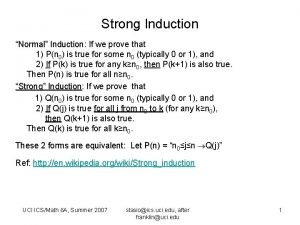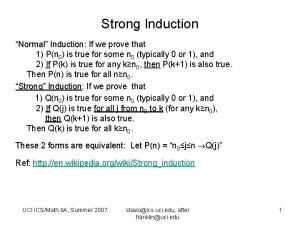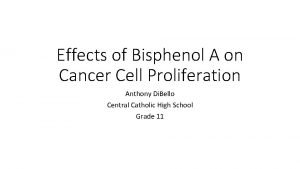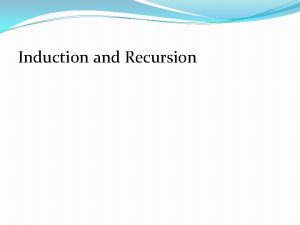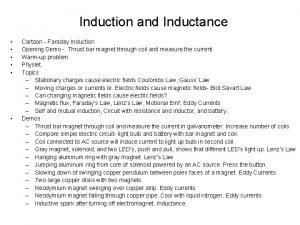Effects of Thymoquinone on Proliferation and induction of




























- Slides: 28

Effects of Thymoquinone on Proliferation and induction of Apoptosis in HTLV-1 Positive and Negative Malignant T-Lymphocytes Steve Harakeh+ *, Marwan El-Sabban‡, Esam Azhar+, Soad Al Jaouni* , Rania Azar†, Mona Diab-Assaf† +King Fahd Medical Research Center, King Abdulaziz University, Saudi Arabia. ‡Human Morphology Department, American University of Beirut, Lebanon. *Department of Hematology and Yousef Abdulatif Jameel Chair of Prophetic Medicine Application, Faculty of Medicine, King Abdulaziz University, Saudi Arabia. †Molecular Tumor-genesis and Anticancer Pharmacology, Lebanese University. 1

Outline • • 2 1. Background/Objective 2. Materials & Methods 3. Results 3. Conclusions and Recommendations.

Background / Objective Ø Adult T-cell leukemia is an aggressive malignancy of activated T cells with no effective treatment so far. It is caused by a retrovirus called Human Tcell Lymphotrophic Virus Type-1 (HTLV-1). Ø For this reason alternative and/ or complementary therapy have been sought. 3

Why Why. TQ? 4 4

Why TQ? • Analgesic: Relieves or dampens sensation of pain. • Anthelmintic: (Also know as vermicide or vermifuge) destroys and expels intestinal worms. • Anti-bacterial: Destroys or inhibits the growth of destructive bacteria. • Anti-Inflammatory: Reduces inflammation. • Anti-Microbial: Destroys or inhibits the growth of destructive microorganisms. • Antioxidant: Prevents or delays the damaging oxidization of the body's cells - particularly useful against free radicals. • Anti-Pyretic: (Also known as ferbrifuge) - exhibits a 'cooling action', useful in fever reduction. • Anti-spasmodic: Prevents or eases muscle spasms and cramps. • Anti-tumour: Counteracts or prevents the formation of malignant tumours* • or relaxation of the bowels. 5

Why TQ? • Carminative: Stimulates digestion and induces the expulsion of gas from the stomach and the intestines. • Diaphoretic: Induces perspiration during fever to cool and stimulate the release of toxins. • Diuretic: Stimulates urination to relieve bloating and rid the body of any excess water. • Digestive: Stimulates bile and aids in the digestive process. • Emmenagogue: Stimulates menstrual flow and activity. • Galactogogue: Stimulates the action of milk in new mothers. • Hypotensive: Reduces excess blood pressure. • Immunomodulator: Suppresses or strengthens immune system activity as needed for optimum balance. • Laxative: Causes looseness 6

Objective • The purpose of this study is to investigate the effects of Thymoquinone (TQ) on proliferation and induction of apoptosis in HTLV-1 positive and negative malignant Tlymphocytes. 7

Test Compound: TQ • A 10 mg/ml solution of TQ (Sigma) was dissolved in Methanol and concentrations of 40 -200 m. M were used. • The volume of methanol used on the cells for treatment did not exceed 1%, because of its toxicity to cells. 8

Results: Cytoxicity/Proliferation Cell lines, growth conditions and treatment • Cell lines • • The two HTLV -1 positive T-cell lines used were: Hu. T-102 and C 91 -PL are HTLV-1 infected CD 4+ T Cells that constitutively produce the virus. • The two HTLV negative T-cell lines used were: CEM and Jurkat. They were grown in RPMI complete growth medium under proper conditions. 9

Cytotoxicity and cell proliferation • Cells were grown in the presence and absence of different concentrations of the test compound for 12, 24 and 48 hours and assayed for cytotoxicity using the Cyto. Tox 96® Non-Radioactive Cytotoxicity Assay Kit. • In the case of proliferation, Cell. Titer 96® Non. Radioactive Cell Proliferation Assay was used. 10

Cytotoxicity • The results indicated that cytotoxicity was apparent in all cell lines at concentrations of 100 µM and above with around 50% of the cell lines remaining alive. • A dose-dependent effect of TQ concentrations on cell survival as expressed in terms of percent survival of control. All Subsequent data were done using only non -cytotoxic concentrations of TQ. 11

Harakeh S et al, figure 1 A C B D Each value is the mean ± SD deduced of three separate experiments done in triplicate. *: p<0. 05, **: p<0. 01. Figure 1: Cytotoxicity and antiproliferative effect of TQ.

Proliferation • C 91 -PL was the most affected, reaching an 84% reduction in proliferation at a concentration of 100 µM. • In HTLV-1 negative cell lines, Jurkat was the most susceptible with a reduction of proliferation of around 77% at 100 µM TQ. • TQ did not show a significant effect on both HTLV-1 positive and negative cell lines at the low concentrations of 20 µM or below except for CEM which showed a 25% decrease in proliferation. 13

TQ/TGF Growth Factors • To explore the anti-proliferative effects of TQ, we looked at its effects on changes in the levels of the growth factors TGF-α, TGF-β 1 and TGF-β 2 involved in the regulation of proliferation. 14

Harakeh S et al, table 1 RT-PCR for TGF m. RNA • We analyzed the TGF m. RNA using RT-PCR carried on the four cell lines after treatment with 20, 60 and 100μM TQ for 24 hours. Levels were checked using ribosomal protein as a control. Primers used are shown in the table below: 15

Harakeh S et al, figure 4 TGF-α TQ (μM) 0 20 60 100 TGF-β 1 0 TGF-β 2 Ribosomal protein 20 60 100 0. 2 0. 4 0. 6 0. 8 0. 4 0. 3 1 1 0. 1 1. 2 1. 1 1 1 C 91 -PL 0. 6 0. 4 0. 1 Hu. T-102 0. 4 0. 2 0. 1 0. 2 0. 6 1. 2 0. 6 0. 4 0. 2 0. 1 0. 8 1. 1 1. 6 1. 8 0. 5 0. 4 0. 3 0. 4 0. 5 0. 6 0. 9 Jurkat 1. 3 1. 2 1 1 1 CEM 1. 4 1. 5 1. 4 1 1 Figure 4. Effect of TQ on m. RNA expression of TGF. The results showed an up-regulation in the levels of TGF-β 1, down regulation in the levels of TGF-α and no effect in the case of TGF-β 2.

TQ/TGF Growth Factors • The results showed that in all the cell lines, regardless of whether the virus was present or absent, there was a down-regulation of TGF-α, and up-regulation of TGF-β 2 while the levels of TGF- β 1 were unaltered. • TGF-β 2 has a role in mediating apoptosis in cells and regulating apoptosis-associated proteins Bcl-x. L and Bcl-2α in vivo, whereas TGF-α plays an anti-apoptotic role in cells via the NF-κB dependent pathway. 17

• TGF- β 1 plays a role as a pro-apoptotic protein. As the levels of TGF- β 2 were not affected and only TGF- β 1 was up-regulated, thus apoptosis induction is likely to be through the combined action of TGFβ 1 and the down-regulation of TGF- α. • It is now known that the expression of TGF-β 1 inhibits T and B cell proliferation. TGF-α is confirmed to have an anti-proliferative effects on cells (Kanai, 2001) while TGF- β 2 has a suppressive effect on interleukin-2 dependent T-cell growth. These results support our findings and propose a theory for the mechanism of action of TQ in malignant cells in vitro. 18

Effect of TQ on apoptosis • Cell cycle analyses were performed using DNA flow cytometry and ELISA assay in order to check for Apoptosis. • DNA Flow Cytometry Analysis • Flow cytometry analysis was done to separate the cells according to their DNA content. Diploid (2 n) indicates G 0/G 1 cells, (>2 n but <4 n) indicate S-phase and (4 n) reflect G 2/M- phase. 19

Harakeh S et al, figure 2 C 91 -PL Hu. T-102 Jurkat CEM Figure 2: Effect of TQ on cell cycle progression.

Apoptosis: Flow Cytometry • Cells were grown in the presence of 0, 20, 60 and 100 µM of TQ for 12, 24 and 48 h. TQ affected cell cycle progression by increasing the proportion of cells in the Pre G 1 phase. • At 12 hours, there was no noticeable effect. • At 24 hours, TQ showed a significant increase in cells in the pre G 1 phase except for CEM. However, a significant increase in cells in the pre G 1 cell cycle was observed at 48 h. • At 24 hours, Hu. T-102 cells, showed highest increase in cell populations in the pre G 1 phase at a TQ concentration of 100 µM at 24 hours (with about a 41 fold increase), Jurkat showed a 31 fold increase in cells in the pre G 1 phase under 21 the same conditions.

Apoptosis: ELISA • Cytosolic histone-associated DNA fragments were quantitatively detected by ELISA in order to measure cell death. • At a concentration of TQ of 100µM, there was a significant increase in the percentages of apoptotic cells as compared to the control (p <0. 05) in the case of Jurkat and Hu. T-102, and in the case of C 91 -PL (p<0. 01). However, a small increase was observed in the case of CEM 22

Harakeh S et al, figure 3 Each value is the mean ± SD deduced of three separate experiments done in triplicate. *: p<0. 05, **: p<0. 01. Figure 3: DNA fragmentation by TQ by ELISA

24

TQ Effect on the expression of cell cycle and apoptosis-related proteins • Western Blot analysis was used to determine the effect of TQ on the pro-apoptotic proteins: p 53 and p 21 and the anti-apoptotic protein: bcl-2α. All cells were treated with the TQ concentrations of 0, 20, 60 and 100 μM for a 24 -h time interval. 25

Harakeh S et al, figure 4 C 91 -PL TQ (μM) 0 20 60 100 Hu. T-102 0 20 60 100 Jurkat 0 20 60 100 CEM 0 20 60 100 P 21 P 53 bcl-2α GAPGH Figure 5: TQ Effects on Proteins involved in apoptosis by Western Blotting. An up-regulation in both of the pro-apoptotic proteins p 53 and p 21 and down-regulation in the anti-apoptotic protein bcl-2α.

Conclusion This study indicated that TQ had : 1. Anti-proliferative effects on both HTLV-1 positive and negative malignant T-lymphocytes. 2. Induced Apoptosis at the Pre G 1 or the G 0/G 1 phase 3. Caused an up-regulation in both of the proapoptotic proteins p 53 and p 21 and down-regulation in the anti-apoptotic protein bcl-2α. 4. Caused a down-regulation of anti-apoptotic growth factor TGF-α, and up-regulation of pro-apoptotic growth factor TGF-β 2. 27 Prof. Bertrand Liagre (University of Limoges in France) is collaborating with us on TQ Research

 Reed sternberg cells
Reed sternberg cells Intimal proliferation
Intimal proliferation Intimal proliferation
Intimal proliferation Proliferation advertising
Proliferation advertising Proliferation of interest groups
Proliferation of interest groups Uncontrolled clonal proliferation
Uncontrolled clonal proliferation Industrial proliferation
Industrial proliferation Folliculocentric basaloid proliferation
Folliculocentric basaloid proliferation Fibrous proliferation
Fibrous proliferation Lymphocyte proliferation
Lymphocyte proliferation Bsbhrm506
Bsbhrm506 Analytical induction in qualitative research
Analytical induction in qualitative research Explication and induction
Explication and induction 3-phase induction motor problems and solutions
3-phase induction motor problems and solutions Sound and unsound argument
Sound and unsound argument Safety induction presentation
Safety induction presentation Charging by induction
Charging by induction Formal vs informal logic
Formal vs informal logic Induction and recursion discrete mathematics
Induction and recursion discrete mathematics Charging by conduction
Charging by conduction U
U Recursive definitions and structural induction
Recursive definitions and structural induction Induction deduction
Induction deduction Difference between induction heating and dielectric heating
Difference between induction heating and dielectric heating Causes and effects of the french and indian war
Causes and effects of the french and indian war Electrostatics
Electrostatics What is analytic induction
What is analytic induction Electric preheating furnace
Electric preheating furnace How to test a 3 phase motor
How to test a 3 phase motor
